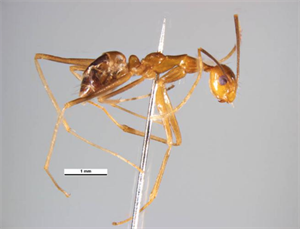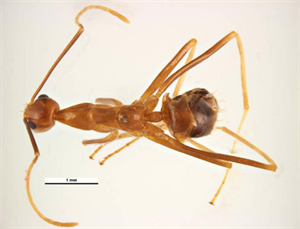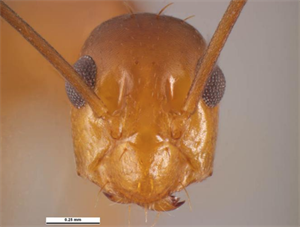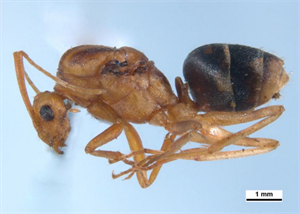Yellow crazy ant, long-legged ant
Pacific Pests, Pathogens and Weeds - Online edition
Pacific Pests, Pathogens & Weeds
Yellow crazy ant (364)
Anoplolepis gracilipes
Particularly, lowland tropical forests. Asia, Africa (restricted), North (restricted), South, and Central (restricted) America, Oceania. It is recorded from Australia, Cook Islands, Federated States of Micronesia, Fiji, French Polynesia, Guam, Kiribati, Marshall Islands, New Caledonia, Niue, Northern Mariana Islands, Palau, Papua New Guinea, Samoa, Solomon Islands, Tokelau, Tonga, Tuvalu, Vanuatu, and Wallis & Futuna.
An ant that favours disturbed agricultural and forest habitats, mostly below 1200 m. It can invade urban areas and become a serious household pest. Many crops are hosts, the attraction being the honeydew from sap-sucking insects: banana, cinnamon, citrus, cocoa, coconut, coffee, durian, mango, rambutan, sugarcane.
The ant is yellow-brown or reddish-brown, with a slender body about 5 mm long, large eyes, extremely long antennae, and a gaster (the large, bulbous part of the abdomen, see photos) darker than the rest of the body (Photo 1-3). All the workers are of similar size. Its fast, seemingly uncontrolled movements, are the reason for its common name. It does not sting, but it can overcome or kill prey by spraying formic acid.
Nests are made in the ground at the base of trees or in the canopy; they are also made under leaf litter, rotten logs, in epiphytes, and holes in trees or in the ground. The ant forms super-colonies over large areas (10-150 ha), with up to 20 million workers per ha.
Food is varied; it is a scavenger. It will use seeds, other parts of plants, honeydew from sap-sucking aphids, scales, mealybugs and whiteflies, other insects, crabs, snails and small vertebrates. It forages day and night, as long as temperatures are above 25°C, limited only by high rain and winds.
Spread occurs by 'budding'. Nests have several queens (Photo 4), and a queen will move out with a few workers and establish a nest nearby. Mating flights of winged queens and males are known, but unclear how successful they are in establishing new colonies. Spread also occurs over long distances in soil of potted plants, in packing material, timber, machinery, and containers shipped around the world.
Anoplolepis gracilipes is known as a 'tramp' ant. These are ants that have become widely distributed globally associated with increased trade and commerce. The impact of the ant on Christmas Island is an example how invasive and devastating the yellow crazy ant can be. Although introduced 60 years ago, populations have escalated in recent years causing many negative events: i) sap-sucking pest species have increased, weakening plant growth; ii) honeydew from these pests have worsened their impact as foliage has been colonised by sooty mould fungi blocking photosynthesis; iii) land crab populations have been decimated causing accumulation of leaf litter, increases of understorey vegetation and shaing out the larger canopy trees; iv) many species of invertebrates, birds, reptiles and mammals are now vulnerable to habitat loss; and v) tourism is threatened by ants that spray formic acid when disturbed.
It is one of the five worst ants threatening the Pacific according to PIAT (Pacific Invasive Ant Toolkit, together with the little fire ant, the red imported fire ant, the big-headed ant, and the Argentine ant (http://www.piat.org.nz/problem-ants/worst-5-identification). It is also among 100 of the World's Worst Invasive Alien Species, published by The Invasive Species Specialist Group (ISSG), a specialist group of the Species Survival Commission of the World Conservation Union. (http://www.issg.org/pdf/publications/worst_100/english_100_worst.pdf).
Look for thin, yellowish brown ants with long legs and antennae, with fast jerky movements when disturbed.
The PIAkey provides diagnostic descriptions of the yellow crazy ant: (http://idtools.org/id/ants/pia/Fact_Sheets/Anoplolepis_gracilipes.html), and numerous photographs.
The app: Antkey Mobile: an identification key for introduced ants. USDA. LUCID, is useful for preliminary examinations, as is the online version: (http://idtools.org/id/ants/pia/PIAkey_v2.html).
The Pacific Invasive Ants Taxonomy Workshop manual has a key to the Pacific species and is well illustrated (http://www.issg.org/cii/Electronic%20references/pii/project_docs/papp/pacific_ants_taxonomy_workshop_2009.pdf).
QUARANTINE
Countries (especially in Africa, the Caribbean, Central and South America) that are still free from, but vulnerable to the yellow crazy ant, need to: (i) define the risk; (ii) have preventive measures in place against an introduction; (iii) have quarantine protocols enacted in case a breach occurs; and (iv) be able to effect a rapid response against this ant and others. It is important to have rapid response procedures in place in case eradication is a possibility. In addition, it is necessary to have biosecurity regulations to prevent movement of the ant within the country, especially in Pacific island countries where most are island groups or archipelagos. Finally, monitoring is required on the islands still free from infestation.
A Pacific Ant Prevention Plan has been written on behalf of the IUCN/SSC Invasive Species Specialist Group and presented to the Pacific Plant Protection Organisation and Regional Technical Meeting for Plant Protection (2004). Anoplolepis gracilipes is one of the 11 species covered (http://issg.org/database/species/reference_files/PAPP.pdf). The Plan focuses on ways to prevent the introduction, establishment and spread of this ant.
Guidelines to assist Pacific island countries and territories in planning effective management of invasive species have also been prepared by the Pacific Community and the Secretariat of the Pacific Regional Environment Programme (http://www.piat.org.nz/uploads/PIAT_content/pdfs/SPREP%20guidelines%20for%20invasive%20species%20management%20in%20the%20Pacific.pdf).
The IUCN/SSC Invasive Species Specialist Group website should be consulted for details on all aspects of eradication and management of invasive ants (http://www.issg.org/).
CULTURAL CONTROL
Hot water at 47°C (and above) kills ants. Hot water up to 49°C will not damage plants. A more extreme method is to use fire to destroy the nests and to create conditions that favour native ant species.
CHEMICAL CONTROL
In general, three types of chemicals are used against ants: (i) stomach poisons. e.g., Maxforce® (fipronil), Amdro® (hydramethylnon), and borax; (ii) insect growth regulators (e.g., Engage® (methoprene), and Distance® (pyriproxyfen); and (iii) poisons that work on the nervous system, that is, neurotoxins, e.g., bifenthrin, fipronil, and imidacloprid. Stomach poisons kill all queens, intercastes and workers; insect growth regulators stop the queens from laying eggs, whereas neurotoxins disrupt insects' central nervous system. It is likely that future products will combine toxins that cause rapid death and insect growth regulators, e.g., Extinguish Plus® (hydramethylnon and methoprene).
A note of caution: Although it is possible to combine a lure (such as peanut butter, fish, sugar, etc.) with a pesticide as an ant bait, it is not recommended because of the danger in leaving concentrated pesticides unattended in the environment, including dwellings.
Treatment options (and case studies) are provided in the Pacific Invasive Ant Toolkit under (http://piat.org.nz/getting-rid-of-ants).
____________________
When using a pesticide, always wear protective clothing and follow the instructions on the product label, such as dosage, timing of application, and pre-harvest interval. Recommendations will vary with the crop and system of cultivation. Expert advice on the most appropriate pesticides to use should always be sought from local agricultural authorities.
AUTHOR Grahame Jackson
Information from CABI Anoplolepis gracilipes (yellow crazy ant) (2018) Invasive Species Compendium. (https://www.cabi.org/isc/datasheet/5575); and Pacific Invasive Ant Toolkit. (http://piat.org.nz); and Anoplolepis gracilipes. AntWiki. (http://www.antwiki.org/wiki/Anoplolepis_gracilipes); and AntWeb. (https://www.antweb.org/description.do?genus=anoplolepis&species=gracilipes&rank=species&project=allantwebants); and from Anoplolepis gracilipes (2018). Global Invasive Species Database.(http://www.iucngisd.org/gisd/speciesname/Anoplolepis+gracilipes). Photos 1-3 Ken Walker (2005) Yellow crazy ant (Anoplolepis gracilipes): PaDIL - (https://www.padil.gov.au/). Photo 4 Amy Carmichael (2005) Yellow crazy ant (Anoplolepis gracilipes). Queensland University of Technology. PaDIL - (http://www.padil.gov.au).
Produced with support from the Australian Centre for International Agricultural Research under project HORT/2016/185: Responding to emerging pest and disease threats to horticulture in the Pacific islands, implemented by the University of Queensland and the Secretariat of the Pacific Community.







